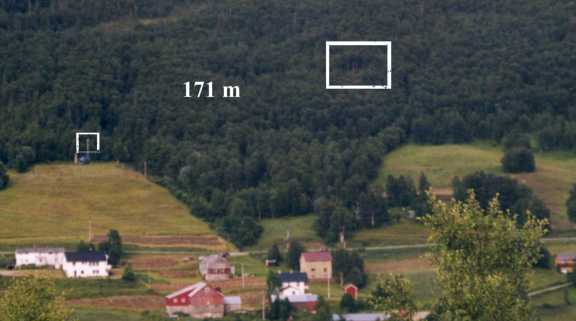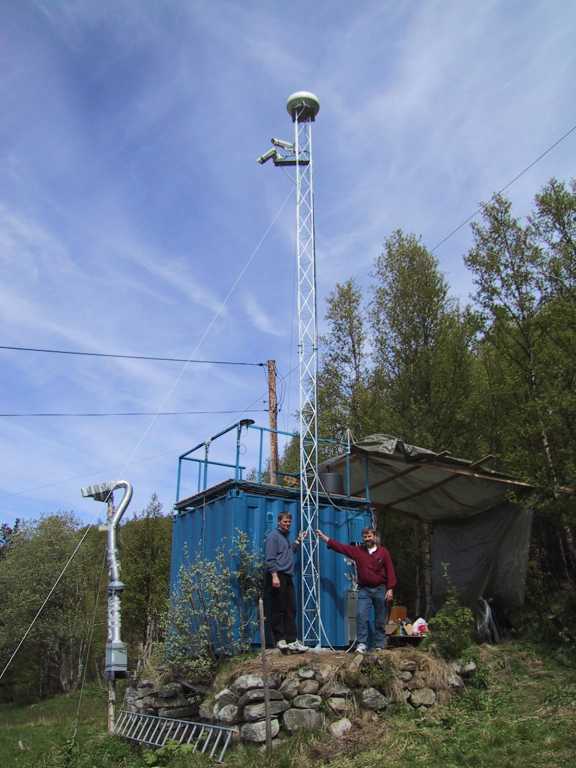

The first part in Hessdalen AMS system 2, was set into operation in the end of
July 2001. It was expanded with a weather station in 2002, and a new
high sensivity black-and-white camera in 2003. I mast was set up in 2001 for the sensors and cameras.
A brief description of the first part in system 2.
System 1 had not the possibility to know the distance to the lights detected. It was also a need to
get an close up picture of what was detected.
System 2 was installed with a "two-camera" computer. Two color cameras, mounted 171 m apart, was connected to this two-camera
computer. With two camera is it possible to calculate the distance to the recorded light.
The software took a picture from each camera each second. If a light show up in both cameras, all
videorecorders startet, direction measured and send to the "pan-tilt" computer,
distance calculated and written on to the pictures, which was sent to the web. The videorecorder stopped
15 seconds later.
The "pan-tilt" computers main task was to steer the pan-tilt unit so it was directed to the light phenomena.
It started with this as soon as the direction signal came from the two-camera computer. A colour
camera with zoom was mounted on the pan-tilt unit. This camera was connected to the pan-tilt computer,
which took an alarm picture when the pan-tilt unit was in the right direction.
Another camera was directed towards the radar screen. As soon as the direction info came from the two-camera
computer, was 5 pictures taken, with 2 seconds between each. The differance between these pictures was coloured
and put on the original radarpicture. It that way would it be possible see what was recorded on the radar.
Both the alarm picture from the zoom camera, and the radar picture was sent to this web.
When we installed system 2 in Hessdalen, did we see that it was a lot of noise on the radarscreen.
The radar "saw" something all the time. Too much to trust this signal. We did never put the pictures from
the radarscreen out on the web because of this "noise". We thought then that we should not have bought the cheapest
radar.
A brief description of the second part in system 2.
System 2 was expanded in 2002 with two more computers. One PC which measured the weather data and sent it
to the this web, and one ELFO PC which measured and analysed the
low frequence electro-magnetic radiation.
The software in the ELFO PC was based on artificial intelligence. If any "unusual" VLF electro-magnetic radiation
showed up, a picture of the signal was sent to the web. All known VLF signales had to be in a database.
Such known VLF signals had to be recorded into the database. This work has not been done. That is the main reason for why these
signals not are sendt out on the web.
The weather PC measured both the temperature, wind direction and speed and air pressure.
The Fluxgate magnetometer was also connected to this computer. The software for the magnetometer was improved from the old system 1,
so it would also detect and record magnetic pulsations.
All data from this weahter PC was send to this web each hour.
A brief description of the third part in system 2.
In the summer of 2003 was system 2 expanded to include a new PC with a black-and-white camera
with very high sensivity (0.0003lux). This should be instead of the old SGI computer from system 1.
The SGI computer managed to capture the flaxes of light. The duration of these lights was
in the order of a fraction of a second. Too short to be captured by the two-camera computer, because
it read first the picture from one camera before it read the next camera. The time used for that was too long
for capturing the short flaxes. We needed a similar system as the one in the SGI computer.
This computer had also a new magnetometer connected, which could measure the absolute value of the magnetic field.
 |
| The location of the two cameras |
 |
| Hessdalen AMS, summer 2001 |
| 